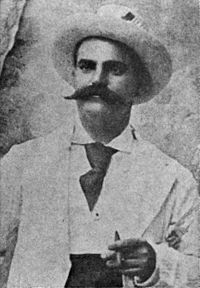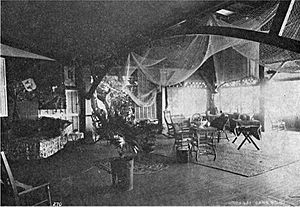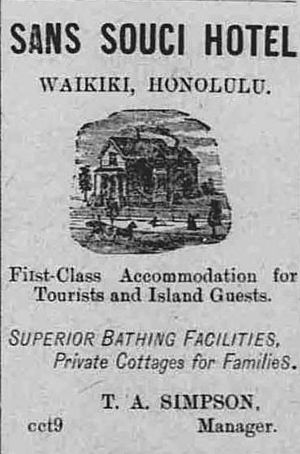George Lycurgus facts for kids
Quick facts for kids
George Lycurgus
|
|
|---|---|

c. 1892
|
|
| Born | 1858 Vasara, Kingdom of Greece
|
| Died | 6 August 1960 (aged 101) |
| Nationality | Greek |
| Occupation | Businessman |
| Spouse(s) | Athina Gerassimos |
| Children | Antigoni, Leo, Nicholas |
George Lycurgus (Greek: Γεώργιος Λυκούργος) (1858–1960) was a Greek American businessman. He played a big part in Hawaii's early tourism. He helped create the Hawaiian Volcano Observatory and Hawaiʻi Volcanoes National Park. He was also involved in some political events in Hawaii's history.
Contents
Early Life and Business Beginnings
George Lycurgus was born in 1858 in Vassaras, a town near Sparta, Greece. After serving in the Greek Army, his father decided to send him to America. In 1877, he traveled to New York City. He worked his way across the country to join his older brother John in California.
In 1881, a relative convinced George to join a fruit trading business. This business shipped fruit between Hawaii and California. He sent California produce and wine to his cousin in Honolulu. His cousin then sent Hawaiian bananas to the mainland.
George later bought a small oyster restaurant in Sausalito, California. He named it the Oyster Grotto. Famous people, like William Randolph Hearst, visited his restaurant. He also became friends with the sons of Claus Spreckels. The Spreckels family owned a shipping company and a sugar business in Hawaii.
In 1889, George accidentally sailed to Hawaii on a Spreckels ship. He only stayed for a week, but he enjoyed it. This led to more trips and longer stays on the islands.
By 1892, George asked his nephew Demosthenes Lycurgus to help him. They started the Pearl City Fruit Company in Hawaii. Eventually, George sold his restaurant in San Francisco and moved to Hawaii permanently.
Hawaii's Changing Times
In 1893, George Lycurgus leased a small guest house on Waikīkī beach in Honolulu. He made it bigger and renamed it the "Sans Souci." This French name means "without care." It became one of Hawaii's first beach resorts. Even famous writer Robert Louis Stevenson stayed there. Today, the area is still known as "Sans Souci Beach."
In 1894, George visited the Kīlauea volcano for the first time. He sailed to Hilo on a ship called the USS Philadelphia. He was very impressed by the volcano. He saw it as a possible future business opportunity.
George became good friends with the Hawaiian royal family. They often visited his resorts. This friendship earned him the nickname "Duke of Sparta." He felt more comfortable with the Hawaiian monarchy than with the American leaders.
In 1893, the Hawaiian Kingdom was overthrown by American businessmen and landowners. They created the Republic of Hawaii. This new government, led by conservative leaders, fined George for selling drinks at his resort. George also had a Hawaiian band play music honoring Queen Liliʻuokalani instead of "The Star-Spangled Banner."
After a failed attempt to restore the queen in 1895, George was accused of helping the royalists. He was arrested and spent 52 days in jail. However, he was never put on trial.
In 1898, Hawaii became a territory of the United States. George Lycurgus then applied to become an American citizen. He opened a new restaurant in Honolulu in 1901. Over the next few years, he became less involved in Honolulu's political scene. In 1908, he bought the Hilo Hotel.
In 1903, George went back to Greece to visit his mother. There, he met and married Athina Gerassimos. She was likely the first Greek woman to live in Hawaii.
The Volcano House and Kīlauea
In December 1904, George and his nephew Demosthenes Lycurgus became major owners of the Volcano House Company. They took over managing the Volcano House hotel. This hotel was located on the Big Island of Hawaii, near the Kīlauea volcano. Demosthenes always introduced him as "Uncle George," which became his new nickname.
Kīlauea volcano had been quiet for almost a year. But two months after the Lycurguses bought the hotel, the volcano erupted! This was good for business.
George eventually worked with Lorrin Thurston for ten years. They worked to make the volcano area into Hawaiʻi Volcanoes National Park. The Lycurgus family kept a special place at the Volcano House to honor Queen Liliʻuokalani. They also shared the legends of Ancient Hawaii with visitors. They would tell stories about the fire goddess Pele, who was said to live in Kīlauea. People believed that prayers to Pele would bring spectacular eruptions, which were great for the hotel's business.
In January 1912, a scientist named Thomas Jaggar arrived to study the volcano. The Lycurgus family helped raise money to build a small building next to the hotel. This building was for scientific tools. By February 1912, construction began on the Hawaiian Volcano Observatory. Jaggar lived there for 28 years. He often gave talks about science to the hotel guests.
In 1914, George was visiting Greece when World War I started. This prevented him from returning to Hawaii. In 1919, his nephew Demosthenes traveled to Greece to get married. Sadly, he passed away from the flu shortly after his wedding. George was finally able to return to Hawaii in 1920.
In 1921, George Lycurgus sold the Volcano House. He moved to Hilo, Hawaii. A shipping company bought the hotel and spent a lot of money to make it bigger.
During the Great Depression in 1932, the shipping company went bankrupt. George bought the Volcano House back for a very small amount of money. Few guests came until the volcano erupted again in 1934. He started a tradition of tossing a special bottle into the volcano.
In 1937, his wife Athena passed away in Hilo. In 1940, a fire destroyed the hotel. It was caused by a kitchen oil burner, not lava! Only a few items, like a koa wood piano, were saved. The old 1877 Volcano House building was used again for guests. Today, it houses the Volcano Art Center.
When he was 81, George traveled to Washington, D.C. He convinced important friends, including President Franklin D. Roosevelt, to help. They arranged for a group called the Civilian Conservation Corps to build a new park headquarters. This allowed George to build a more modern hotel. He reopened the new Volcano House in November 1941.
After another eruption in 1952, at 93 years old, George arranged a special event. He rode a horse to the edge of the erupting volcano and tossed in his ceremonial bottle. Even though park officials tried to stop it, the event happened. It pleased the people watching and the news reporters. The Volcano House was updated again in 1953. George Lycurgus passed away on August 6, 1960, at the age of 101. He was said to be the oldest man in Hawaii.
Biography






